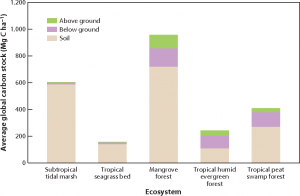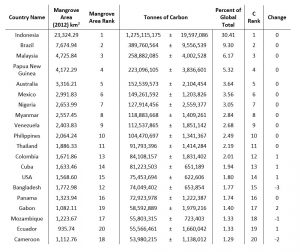![]() Coastal ecosystems such as mangrove forests, seagrass beds and salt marshes play an important role in mitigating climate change (Coastal Blue Carbon). They colonize a relatively small part of our planet, but bind highly efficient carbon: mangroves store significantly more carbon than other tropical and subtropical ecosystems (see Figure 1).
Coastal ecosystems such as mangrove forests, seagrass beds and salt marshes play an important role in mitigating climate change (Coastal Blue Carbon). They colonize a relatively small part of our planet, but bind highly efficient carbon: mangroves store significantly more carbon than other tropical and subtropical ecosystems (see Figure 1).
They store carbon in living aboveground biomass (leaves, stems, branches), belowground (roots), in non-living biomass (foliage and deadwood), but especially in their soils – thus makes “blue carbon” ecosystems outstanding. In their biomass, carbon is stored for decades and in sediments over millennia. Mangroves do not become saturated with carbon because sediments accrete vertically in response to rising sea level. For example, mangrove forests in Belize have accreted C-rich deposits >10m thick and are over 6000 years old (McKee et al., 2007). Indonesia, Brazil and Malaysia have the largest mangrove and carbon stocks (see Figure 2).
Land-use changes lead to CO2 emissions through the clearing of vegetation, forest fires and agricultural activities. Deforestation is the second largest human source of carbon dioxide, accounting for 8 – 20% of all global emissions (van der Werf et al., 2009). It is estimated that around 130 million tons of CO2e (a metric measure used to compare the emissions from various greenhouse gases on the basis of their global-warming potential) are released each year through the deforestation of mangrove forests (Siikamäki et al., 2013). Furthermore, results showed that degraded mangroves stored significantly less carbon in aboveground biomass, belowground biomass and in their sediments compared to intact mangroves (Senger et al., 2020).
The most effective way to maintain wetland carbon pools and prevent emissions to the atmosphere is avoiding conversion and drainage through protection and sustainable management (Crooks et al., 2011).

